The Fukushima Fallout
Hunting for Hope Amid the Ocean’s Biggest Nuclear Disaster Ever
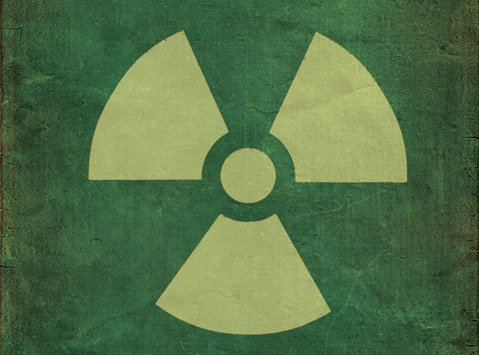
The panic started sometime after the New Year. It found its way to my inbox and my Twitter feed, took up residence on my Facebook wall, and dominated conversations with friends and colleagues. I read reports titled “Holy Fukushima — Radiation Already Killing North Americans” and “28 Signs That the West Coast Is Being Absolutely Fried with Nuclear Radiation from Fukushima” and “The Worldwide Nuclear Crisis That No One Is Talking About.” These were no-holds-barred declarations that Japan’s Fukushima nuclear disaster was now a threat to life as we know it here on the West Coast. Beautifully illustrated with maps showing wide-ranging radioactive fallout, these stories were being read, believed, and then shared by intelligent folk around the globe. After all, fear, truly visceral fear, the kind nuclear fallout ignites, has always tended to spread like wildfire — even before we had social media to fan the flames.
With nuclear events historically shrouded in misinformation and bureaucratic double-speak, it was anything but surprising that the drumbeat of terror grew. The mainstream media largely ignored these reports of deadly oceans and nuclear fish, so into this information vacuum rushed even more doomsday stories. Inundated and eventually swept up in the emotion of it all, I found myself asking my wife in all seriousness if we should consider selling our home before the Fukushima fallout caused the coastal real estate market to crash. Saying this out loud sparked something with my internal bullshit meter, and I realized how truly uninformed I was. On the spot, I decided to put my journalistic chops to work and start talking to real people working in the real world rather than letting my brain continue to spin in the cyber cycle.
In the two months since, I have interviewed crusty, research-hardened college professors, big-brained nuclear chemists, and a professional surfer and filmmaker who bought his own Geiger counter. And, when those conversations confused the hell out of me, I braved the wilds of the Internet, consuming all that I could find on the topic while going down a Google-powered rabbit hole.
Turns out, at least when it comes to Fukushima radiation leaking widespread disaster here in the states, FDR was right; the only thing we have to fear is fear itself …Well, sort of.
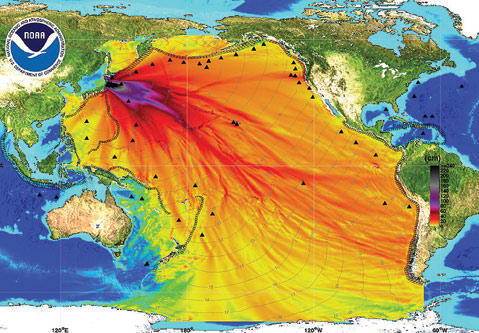
The Color of Disaster
The trouble began three years ago, on March 11, 2011, when the Tōhoku Earthquake rocked Japan. Measuring 9.0 on the Richter scale, within an hour it birthed a tsunami more than 40 feet tall. That massive wall of moving ocean blasted the Fukushima Daiichi nuclear power plant along the northeast coast of Japan. The protective harbor and 30-foot seawall fronting the facility proved no match for Mother Nature. By the end of the day, tens of thousands of lives would be lost.
Shortly after the seawall was obliterated, the power went out and, soon thereafter, the backup generators (located in the lowest areas of the plant) flooded, forcing the backup-backup generators to kick on. Battery-powered devices, the backup-backups were the only things still working that could keep Fukushima’s three nuclear cores somewhat cool immediately after the devastating one-two punch. When those ran out of juice, the real shit storm began. By the afternoon of the 12th, the worst nuclear disaster the world has seen since Chernobyl was well underway. A series of hydrogen explosions compromised the steel containment buildings surrounding the reactors, forcing 300,000 area residents to be evacuated. Highly radioactive fuel rods, sited roughly 600 to 800 feet from the water’s edge, melted. Leaks, gas bleeds, and flooding continued in earnest. Estimates vary widely as to how much nastiness escaped during those first few days, but it is safe to say that very dangerous amounts of very dangerous and potentially life-altering radioactive isotopes such as cesium-134, cesium-137, iodine-131, strontium-90, uranium, and plutonium ended up exactly where we all hope they never do: in the air and the water and the food chain. By March 16, traces of some of these isotopes were detectable in the continental United States.
Tens of thousands of residents remain unable to return to their homes. Fisheries, critical to Japan’s economy and culture, are closed. And there is no end in sight.
Fast-forward to today and, despite gargantuan efforts by the Tokyo Electric Power Company (TEPCO), the flow of radioactive waste into the environment continues. Tens of thousands of residents remain unable to return to their homes. Fisheries, critical to Japan’s economy and culture, are closed. And there is no end in sight.
The melted nuclear fuel is still steaming hot, a constant visual reminder of this truly unprecedented environmental disaster. Never before has so much radiation been released into the ocean in one spot in the history of our planet. As you read this, it continues to the tune of 300 tons of radioactive water a day. (For perspective’s sake, that is enough water to fill an Olympic swimming pool every 8 days). In order to keep the reactors at the magic stabilizing temperature of 212 degrees Fahrenheit, TEPCO and its crews have to keep the fuel, now believed to have melted its way down into the basements of the containment facilities, under a constant cooling flow of water. Upward of 700,000 liters of water are pumped in every day as part of this effort. Add to this hundreds more liters of natural groundwater seepage that finds its way into the basements, and you have yourself one heck of a water-control problem.
In a perfect-world scenario, none of that water would ever find its way into nature. To that end, TEPCO has been building around the clock 250,000-gallon steel storage tanks to hold the radioactive wastewater. By now there is already an extensive tank farm on the property and, based on conservative estimates, TEPCO will run out of storage space within the next three years, a long time before they will be done with the daily water-cooling routine. You don’t have to be a math wizard to know that no good can come from this formula. Furthermore, these tanks occasionally leak and, when that happens, like it did in late February when two valves were accidentally left open, thousands of gallons of terribly radioactive wastewater joins the aforementioned 300 tons of uncontrollable leaks flowing daily into the environment.
And, if this weren’t evidence enough of an unfathomably awful situation, consider just what drastic, sci-fi-inspired measures are being taken by TEPCO. Hoping to prevent the daily escape of radiation into the ocean, the agency, which has ambitiously pledged to decommission the entire plant by mid-2020, is spending hundreds of millions of dollars to construct a giant underground retaining wall that, via a series of cooling pipes, could essentially become a perpetual ice wall capable of containing the leaks. This project includes inventing robots that can clean the fuel rods, as well as utilizing a new radiation water-filter system that they hope could treat the contents of their toxic tank farm making the water safe enough to someday release into the ocean. According to Japanese officials, that filter system has already successfully treated more than 12 million gallons of polluted water, removing all traces of cesium and strontium and 60 other radioactive nuclides. Unfortunately, the system cannot remove tritium, a hydrogen isotope linked to cancer, so it seems all but certain that, at some point, Japan will release millions upon millions of gallons of tritium-tainted water into the sea.
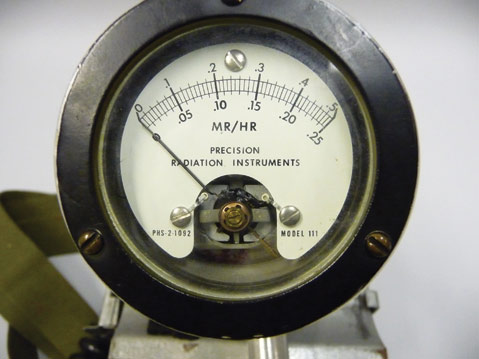
Don’t Worry, Be Happy
“For the ocean, this is certainly an unprecedented event, and we should be concerned and we should be diligent. However, when it comes to human health here in the United States, I am confident in saying I don’t think there will be any impacts,” explained Ken Buesseler, a senior marine and geochemist at the Woods Hole Oceanographic Institute in Massachusetts. Buesseler is quite possibly the closest thing the world has to an expert on what Fukushima has been doing to the Pacific. He cut his radioisotope research teeth studying what Chernobyl did to the Black Sea back in the mid-’80s and has been studying man-made and naturally occurring radionuclides in the water ever since. Among the first international researchers to reach the Fukushima region in the weeks after the meltdown, he has returned multiple times. In fact, he is there right now. “It’s certainly been surprising, all the environmental alarm [in the United States],” said Buesseler the day before his most recent departure.
According to him, the data mined from collection points throughout the Pacific shows that Fukushima-related radiation is certainly present and on the rise, but the levels remain so far below what the Environmental Protection Agency (EPA) considers dangerous to human health that it is actually laughable. The primary radionuclides that Buesseler has been on the lookout for are cesium-134 and cesium-137. (Though iodine-131’s eight-day half-life means it has nearly disappeared from the environment, other evil players — certain strontium and plutonium isotopes — feared to have been released by the Fukushima meltdown have half-lives that mean the potentially harmful chemicals will be with us for a long, long time. Specifically, strontium-90 has a roughly 29-year half-life, plutonium-239 has a 24,100-year half life, and Plutonium-240 enjoys a 6,560-year half-life. However, it is believed that these toxic pollutants have posed and continue to pose a threat to only those in the immediate Fukushima area and thus are not part of the Pacific-wide ocean-testing efforts.)
Cesium-134 and cesium-147 move through the ocean like salts and are uploaded into your body or the body of a fish in the same way salt would. Because of the half-life of these things, we know that any cesium-134 that is detected comes from Fukushima, while the cesium-137 could also be attributed to other historic nuclear events as its half-life is around 30 years, meaning it will remain in the environment for up to 300 years. To date, based on water samples that include tests done right here in the Santa Barbara Channel, Buesseler has found zero evidence of cesium-134 anywhere in the continental United States and such low levels of cesium-137 that it can be safely assumed it is ambient radiation left over from other nuclear events occurring many years ago. Specifically, the levels he is seeing are around 1 to 3 Bq/m3³ (Becquerels per cubic meter), Becquerels being the typical unit of radiation measurement present in a substance. The EPA states you can consume up to 7,400 Bq/m³ in drinking water before you have any negative health risks. In the first months after the disaster, Buesseler was getting readings of around only 4,000 Bq/m³ in the waters near Fukushima.
Buesseler is quick to caution that an uptick in cesium readings is inevitable as the plume of Fukushima radiation is indeed making its way across the Pacific. “California doesn’t have any evidence of this radiation yet, but yet is the key word,” he warned. “Every dispersion model suggests that these levels will go up.” However, based on readings taken from the plume itself and from regions through which it has already passed, he is confident that the cesium amounts will max out at around 30 Bq/m³, still a far cry from the safety threshold of 7,400, and even further from the earth-damning levels many web stories will have you believe are already here. Depending on weather patterns, Buesseler expects that slightly higher cesium levels could start showing in Southern California samples later this spring. Even better, thanks to his research, much of which has been paid for by Internet-based crowd-funding, we now have a solid baseline of info to better understand just what those new levels may mean.
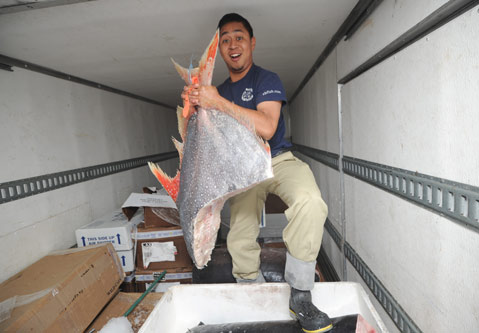
So now that we know we can still safely swim in our ocean, the question becomes: What about the fish we love to eat, or the seaweed? One report that went viral last year claimed that Fukushima radiation was detectable in bluefin tuna caught off California. That certainly curbed people’s appetites. Some Santa Barbara restaurants even stopped serving fish caught in the Pacific. Enter Dr. Nick Fisher, the Stony Brook University professor and marine biogeochemist behind the bluefin findings. “Sure enough, Fukushima radiation was clearly detectable, but the levels were very low. They are lower than what you might be exposed to while flying to New York or eating a banana,” Fisher said, “both of which expose you to small amounts of radiation that you never think twice about.”
He has run the numbers on hundreds of bluefin and yellowfin samples from U.S. waters. “The levels have been going down every time,” said Fisher.
Fisher, who was involved in some of the same Japanese expeditions as Buesseler, collected his first bluefin sample off of San Diego in August of 2011. The bluefin, which spawn near Japan but migrate across the Pacific, eating all sorts of smaller fish along the way, are considered a great indicator of radiation’s presence in the food chain. He has run the numbers on hundreds of bluefin and yellowfin samples from U.S. waters. “The levels have been going down every time,” said Fisher. Yellowfin, which don’t migrate to Japan, actually had zero cesium-134 and only trace amounts of 137, which Fisher attributes to older nuclear releases. He believes this proves that, at least for now, Fukushima radiation is definitively not impacting fish in the eastern Pacific. Fisher also ran probability tests to discover if eating radioactive bluefin could cause cancer. If you ate nothing but affected tuna all day, every day, for 50 years, his numbers showed only two additional cancer fatalities per 10 million consumers. “I am certainly not losing sleep over consuming bluefin by the time they get to California or any fish that is already here,” concluded Fisher.
As for seaweed, Fisher, as well as California State University Long Beach scientists, have been testing kelp samples from Southern California waters, including Santa Barbara, since the meltdown, and the message appears to be much the same: no worries. Early samples of seaweed showed trace amounts of iodine-131, a radioisotope that can be hazardous at high levels, but the levels here were too low to cause concern. Iodine-131 has a half-life of about 8 days and, since all subsequent samples have been negative, it is safe to say that it is gone. According to Fisher, none of the samples have shown any indication of cesium-134, the radioisotope with a half-life that would all but guarantee that it came from Fukushima. “It is important to remember, at least for context, that the ocean is full of all sorts of naturally occurring radiation, and that is what accounts for much of what we have found and continue to find,” said Fisher.
On Second Thought
But, despite the mounting scientific evidence that there is little to be concerned about here in the U.S., the worry remains. One reason, at least according to Barbara Rose Johnston, a senior research anthropologist at the Center for Political Ecology in Santa Cruz, is that governments have a long history of lying about health risks resulting from nuclear exposure. Having studied the effects of the 12 years that the United States’ tested nuclear bombs in the Marshall Islands, Johnston knows that cover-ups were commonplace and that radiation exposure can cause a wicked assortment of illness. “Look, people remember all the secrecy and misinformation about nuclear hazards during the Cold War, so now they are thinking, here we go again, and can you blame them?” she asked.
It certainly has been difficult to obtain facts about Fukushima: TEPCO’s public release of information has been consistently misleading, regularly changing reported spill numbers and levels of radiation entering the water or air. They denied outright the daily spills until last July when, under pressure from independent scientists, they caved, admitting that Fukushima was, in fact, leaking 300 tons of radioactive wastewater a day since 2011. Add to this the fact that the U.S. has lowered the acceptable levels of cesium-134 and 137 in fish and drinking water since the meltdown, and you can see how easy it is for conspiracy theories to take root.
But perhaps the biggest fear-breeding factor in all this is that there is no single governmental agency responsible for monitoring nuclear fallout in the ocean. The EPA, the National Oceanic and Atmospheric Administration, and the International Atomic Energy Agency all say the responsibility falls outside of their jurisdictions. “You end up with a worldwide disaster like this, and no one is immediately responsible for measuring the impacts,” complained Buesseler, expressing a sentiment shared by virtually every scientist and researcher I interviewed. This lack of accountability raises challenges not only for journalists trying to cover the issues but also for citizens simply trying to asses their own risks.

The other issue stemming from the Fukushima fallout legacy is the public’s growing concern about low-level radiation exposure, a subject about which even the experts agree we know little. Science can only tell us that Fukushima radiation is not dangerous to Californians. But what if there were an uptick in overall radiation levels that Fukushima had helped inch forward? What would be the tipping point — if we included all the other daily radiation sources such as cell phones, Wi-Fi, and smart meters — that would create a toxic brew our human bodies could not handle?
“We simply don’t know where that is,” said Dr. Stephen Hosea, an infectious-disease expert based at Cottage Hospital with an internationally recognized reputation for his work on the HIV and swine flu epidemics. He is now focused on the impacts of low-dose radiation exposure on humans. Last year, he attended a talk about Fisher’s bluefin study. Hosea had just eaten fresh bluefin from San Diego and was horrified. “I literally gagged on the spot because I knew what cesium can do to you,” he recalled. “I couldn’t believe I was hearing about [the study] for the first time.”
“The greatest threat to life in Santa Barbara as I know it is Diablo Canyon.”
Hosea has now joined the movement against Diablo Canyon Nuclear Power Plant’s re-permitting efforts. Less than two hours north of Santa Barbara in San Luis Obispo, Diablo is a coastal plant similar in design to Fukushima that, also like Fukushima, sits on a series of fault lines. From its very beginnings nearly 50 years ago, there has been public concern over its safety and health threat, but now the outcry for its closure is growing. With prevailing winds and ocean currents promising that any Diablo accident would soon arrive in Santa Barbara, Hosea is not alone when he says, “The greatest threat to life in Santa Barbara as I know it is Diablo Canyon.”
But his worry isn’t just limited to the risk of a Diablo disaster. It also includes the long-term risk of living in an ever increasingly radiated world. Perhaps that mindfulness is the real Fukushima takeaway that we should be putting on our Facebook walls. As Hosea put it, “We already know unequivocally that exposure to radiation on any scale isn’t good for us.”
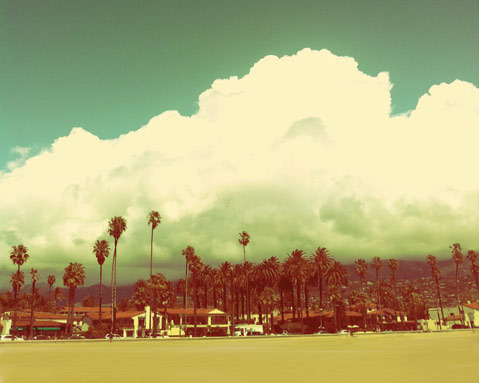
The Santa Barbara Situation
Santa Barbara ChannelKeeper, a nonprofit coastal watchdog, has been monitoring radiation levels in our Pacific neighborhood, providing samples for Ken Buesseler’s Woods Hole Institute water-testing efforts as well as for California State Long Beach’s Kelp Watch project. “So far, there is just no evidence to suggest that we have anything to worry about. Really, people should be more worried about mercury in their fish than anything from Fukushima at this point,” said Jenna Driscoll, the Watershed and Marine Program associate at ChannelKeeper, last week. “The highest levels that are being reported are such a minuscule amount; they are more than 1,000 times less than an X-ray you would get at the dentist.”
And, if that isn’t reassuring, then consider the findings of Dr. Claudia Benitez-Nelson at the University of South Carolina. A former grad student of Buesseler’s, Benitez-Nelson has been studying algae blooms in the S.B. Channel for years and, as a result, has been harvesting data since well before Fukushima. She believes there is “absolutely no evidence” of Fukushima radiation thus far in our stretch of the Pacific. “I know people are scared, but we just aren’t seeing anything that causes alarm,” explained Benitez-Nelson.
According to Driscoll, both projects will continue to monitor radiation levels in years ahead.
Editor’s Note: This story was corrected on April 8, 2014. The original version erroneously stated that Ken Buesseler of Woods Hole is not looking for radionuclides from strontium and plutonium in the ocean because they have “disappeared” from the environment. This is not true. The half-lives of certain strontium and plutonium isotopes feared to have been released by the Fukushima meltdown are such that the potentially harmful chemicals will be with us for a long, long time. Specifically, strontium-90 has a roughly 29 year half-life and plutonium-239 has a 24,100 year half life while Plutonium-240 enjoys a 6,560 year half-life. However, it is believed that these toxic pollutants have posed and continue to pose a threat to only those in the immediate Fukushima area and thus are not part of the Pacific-wide ocean testing efforts.



